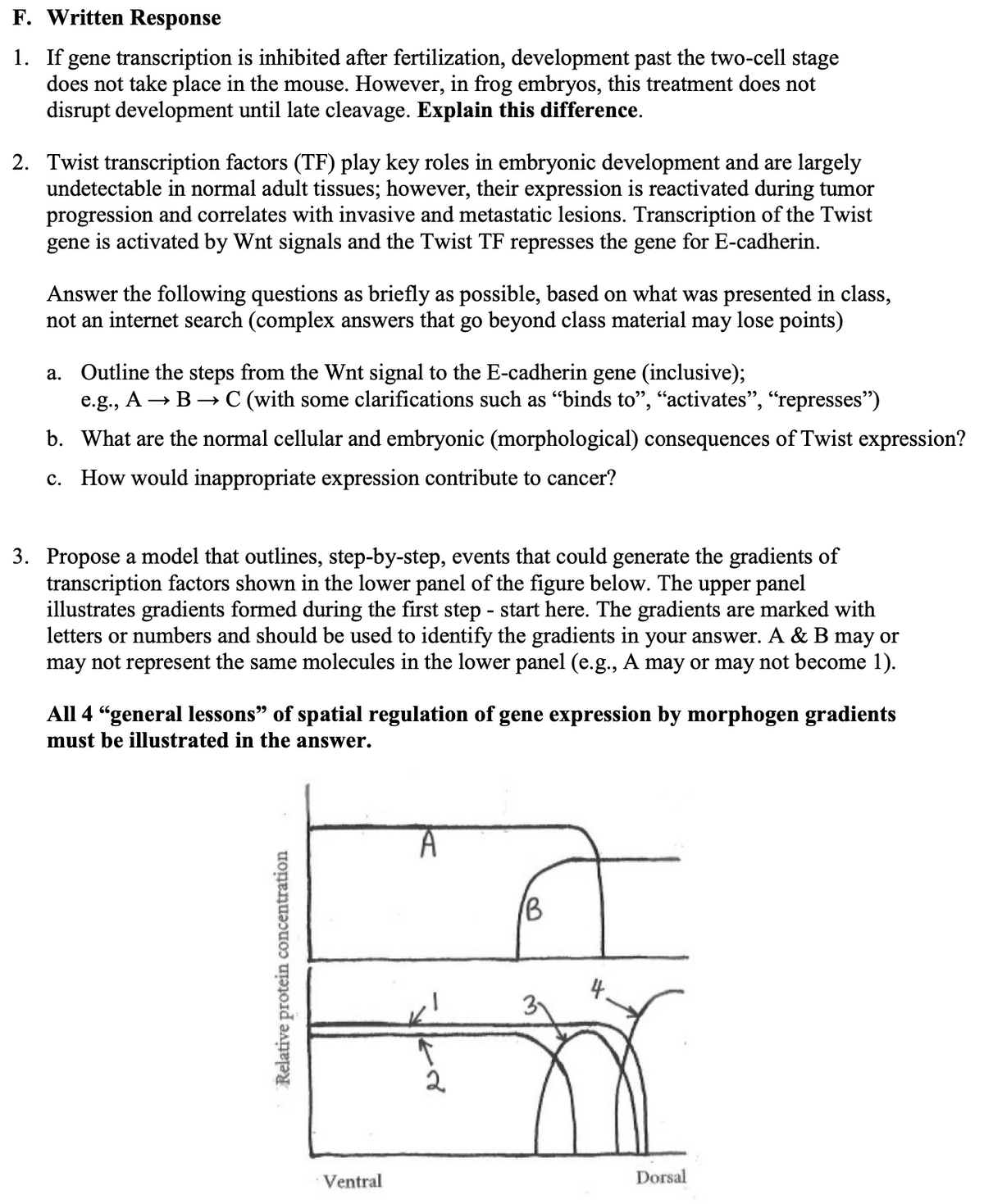1. If gene transcription is inhibited after fertilization, development past the two-cell stage does not take place in the mouse. However, in frog embryos, this treatment does not disrupt development until late cleavage. Explain this difference.
1. If gene transcription is inhibited after fertilization, development past the two-cell stage does not take place in the mouse. However, in frog embryos, this treatment does not disrupt development until late cleavage. Explain this difference.
Biology: The Dynamic Science (MindTap Course List)
4th Edition
ISBN:9781305389892
Author:Peter J. Russell, Paul E. Hertz, Beverly McMillan
Publisher:Peter J. Russell, Paul E. Hertz, Beverly McMillan
Chapter50: Animal Development
Section: Chapter Questions
Problem 10TYK
Related questions
Question

Transcribed Image Text:F. Written Response
1. If gene transcription is inhibited after fertilization, development past the two-cell stage
does not take place in the mouse. However, in frog embryos, this treatment does not
disrupt development until late cleavage. Explain this difference.
2. Twist transcription factors (TF) play key roles in embryonic development and are largely
undetectable in normal adult tissues; however, their expression is reactivated during tumor
progression and correlates with invasive and metastatic lesions. Transcription of the Twist
gene is activated by Wnt signals and the Twist TF represses the gene for E-cadherin.
Answer the following questions as briefly as possible, based on what was presented in class,
not an internet search (complex answers that go beyond class material may lose points)
a. Outline the steps from the Wnt signal to the E-cadherin gene (inclusive);
e.g., A → B → C (with some clarifications such as "binds to", "activates", "represses")
b. What are the normal cellular and embryonic (morphological) consequences of Twist expression?
c. How would inappropriate expression contribute to cancer?
3. Propose a model that outlines, step-by-step, events that could generate the gradients of
transcription factors shown in the lower panel of the figure below. The upper panel
illustrates gradients formed during the first step - start here. The gradients are marked with
letters or numbers and should be used to identify the gradients in your answer. A & B may or
may not represent the same molecules in the lower panel (e.g., A may or may not become 1).
All 4 "general lessons" of spatial regulation of gene expression by morphogen gradients
must be illustrated in the answer.
Relative protein concentration
Ventral
A
↑
2
/B
Dorsal
Expert Solution
This question has been solved!
Explore an expertly crafted, step-by-step solution for a thorough understanding of key concepts.
Step by step
Solved in 4 steps with 1 images

Knowledge Booster
Learn more about
Need a deep-dive on the concept behind this application? Look no further. Learn more about this topic, biology and related others by exploring similar questions and additional content below.Recommended textbooks for you

Biology: The Dynamic Science (MindTap Course List)
Biology
ISBN:
9781305389892
Author:
Peter J. Russell, Paul E. Hertz, Beverly McMillan
Publisher:
Cengage Learning

Biology 2e
Biology
ISBN:
9781947172517
Author:
Matthew Douglas, Jung Choi, Mary Ann Clark
Publisher:
OpenStax

Biology: The Unity and Diversity of Life (MindTap…
Biology
ISBN:
9781337408332
Author:
Cecie Starr, Ralph Taggart, Christine Evers, Lisa Starr
Publisher:
Cengage Learning

Biology: The Dynamic Science (MindTap Course List)
Biology
ISBN:
9781305389892
Author:
Peter J. Russell, Paul E. Hertz, Beverly McMillan
Publisher:
Cengage Learning

Biology 2e
Biology
ISBN:
9781947172517
Author:
Matthew Douglas, Jung Choi, Mary Ann Clark
Publisher:
OpenStax

Biology: The Unity and Diversity of Life (MindTap…
Biology
ISBN:
9781337408332
Author:
Cecie Starr, Ralph Taggart, Christine Evers, Lisa Starr
Publisher:
Cengage Learning

Biology: The Unity and Diversity of Life (MindTap…
Biology
ISBN:
9781305073951
Author:
Cecie Starr, Ralph Taggart, Christine Evers, Lisa Starr
Publisher:
Cengage Learning
